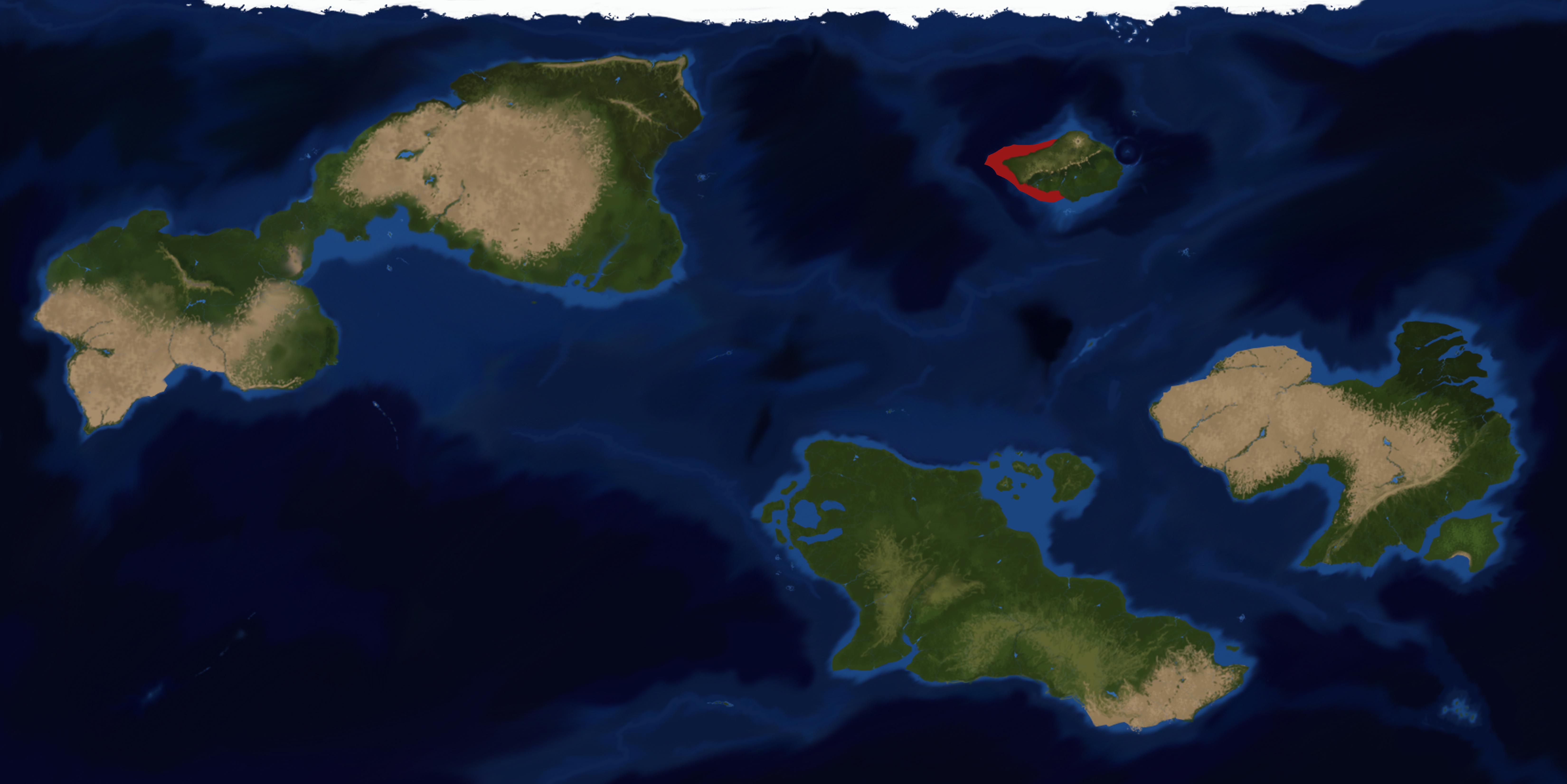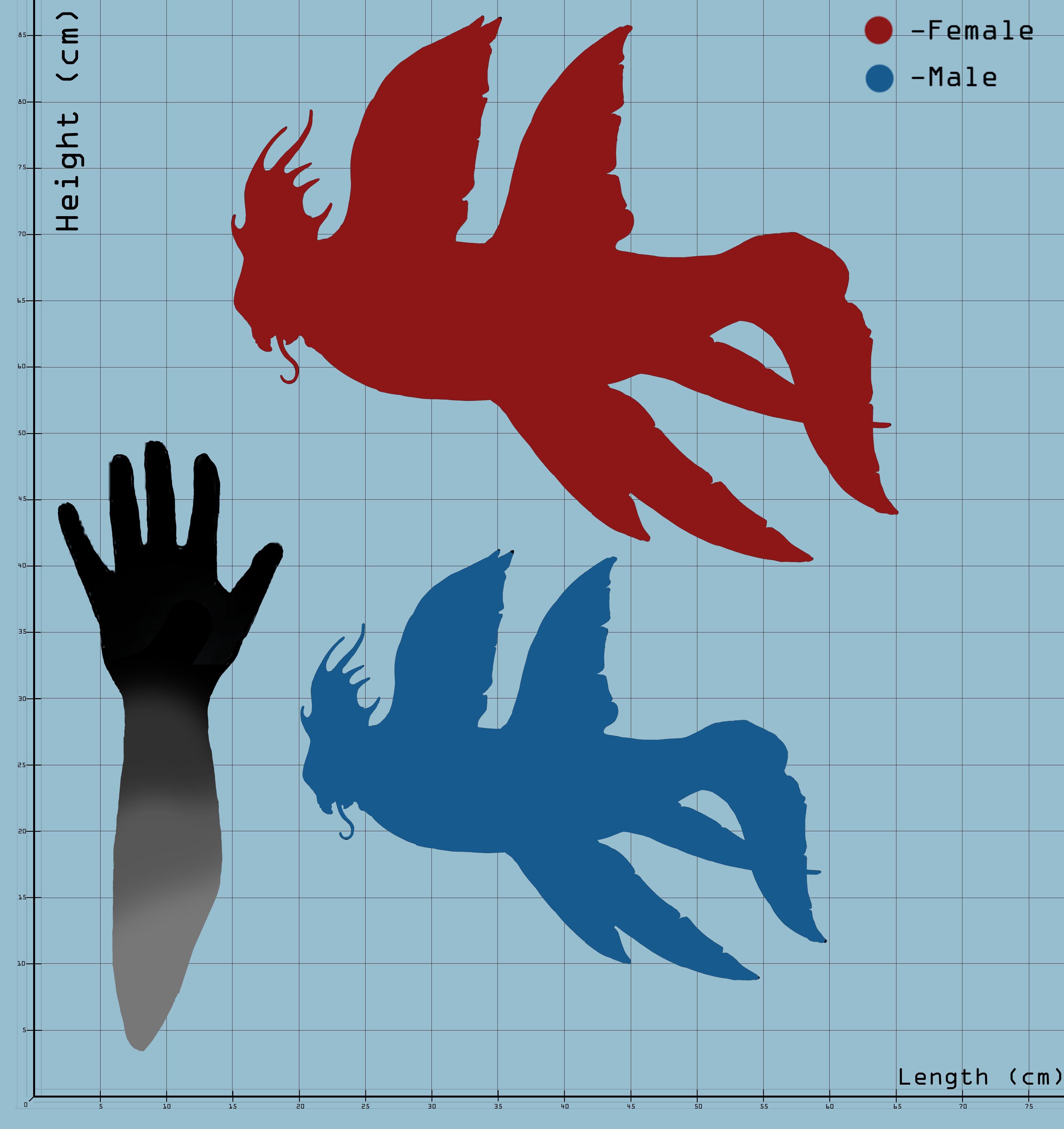Cockatielfish
Psittacosteocristi navimorphus is perhaps one of the few real specialists of Tauria.
Feeding only on the long tendrils of the Gleann Blàthanna’s Balloon trees, this amphibian evolved a strong beak and a long and prehensile tongue to cut and manipulate its food source.
This animal takes it’s genus name from the striking resemblance to Earth’s Cockatiels (Nymphicus hollandicus) and Cockatoos (Cacatua galerita) while the species name takes from the peculiar locomotory system the fish evolved: P. navimorphus has evolved to move much like a sailship, using the upward pointing Pectorals as sails and the downpointing Caudal as a helm to steer; for thrust, P. navimorphus uses its Anal fins as oars.
Other peculiarity of this animal is the buoyancy that it achieved by filling specialized air sacs under the chest with gasses such as Methane and Air, keeping the creature afloat; P. navimorphus can, however, submerge itself, by expelling the gasses from the sacs: it will then move the Pectoral fins from the upward pointing position to the pronated position, using those for active locomotion as well.
This amphibian is often consumed raw by fishermen just as they capture it during long fishing sessions as a snack or a quick lunch.
Basic Information
Anatomy
- Head small compared to body with downpointing mouth and big eyes; presence of a complex bony crest on the dorsal area of the cranium.
- Specialized prehensile palatolingualis apparatus.
- Pectoral fins upward pointing, sail shaped, able to pronate.
- Dorsal fin sail shaped with robust internal bone structure.
- Anal I and II elongated with powerful musclolature.
- Enlarged thorax with internal airsacks; syphon on the anterior section of the thorax for gas expulsion.
- Short Gill tail with a low ridged Gill fan.
- Upper caudal missing, Lower caudal elongated.
Genetics and Reproduction
Seasonal monogamy.
Psittacosteocristi navimorphus enters heat during the summer season, when balloon trees disseminate.
The females of the species will signify their receptivity by swimming belly side up near the surface energetically; this bizzare display attracts the males of the species who will start fighting over the female by flashing the bony crests with beautiful displays of color and shapes.
The winner is decided by the most complex color pattern and speed at which the animal is able to produce it.
The winning male will copulate with the female whilst she still energetically swims belly side up; the male and female will chase eachother both belly side up near the surface, zigzagging between the balloon tree's tendrils; once the male manages to catch up to the female, it will anchor itself to her egg duct with his extremely long prehensile parapenis, using hooks on its body to keep attached to her; he will the let her carry him for the time needed for him to fertilize her, at which point he will detatch and the female will stop her display.
The egg incubation period is of three days before deposition; a female will lay her eggs on the bottom of the shallow sea, inside the dead body of a balloon tree.
Growth Rate & Stages
Ontogenesis from spawn to adult is evident; spawns lack the bony crests of adults and posses a small, atrophic, upper caudal fin.
Loss of the natal aculeus happens during the first week of life.
The spawn will hatch a couple weeks after deposition, eating their way out of the rotting plant; the first thing they do one outside is a mad run towards the surface, where they will fill their air sacs for the first time and find shelter in the floating balloons and their tendrils.
At this early stage, the young spawn will mainly feed on young balloon trees anchored to the seafloor; this food source is dangerous to reach though, as many predators lurk between the surface forest and the sea floor.
Of the roughly three hundred spawns a single female lays in a single mating season, only an average of twenty of those reach adulthood.
Ecology and Habitats
These amphibian are epipelagic, living from 1 to 10 m deep.
They are closely linked to the Balloon forests they live in and give them both food and cover.
Dietary Needs and Habits
Psittacosteocristi navimorphus is a specialist, adapted for the environment it lives in to a fault.
They only feed on Balloon trees and share most of the lifecycle in close relation with the plant.
Biological Cycle
After a period of hyperactivity in the summer, when the balloon plants disseminate, they enter long intermidiate periods of lowered activity where they feed on as many plants they get, increasing body mass substaintally.
During the winter season they enter a stasis period where they hardly move at all, consuming most of the body mass aquired during the intermidiate season; this happens as, during winter, the Balloon trees retract the tendrils inside their sacs, leaving little food and protection for the amphibians.
They will find space inside the occupied sacs of the Balloon trees to enter stasis; inside the sacs these animals will squeeze one against the other, providing warmth to eachother.
In this stage they will still communicate between themselves with crest color changes.
Additional Information
Social Structure
Very social.
These animals actively search for conspecifics and like to live in small schools, communicating between members by the means of their crest.
They are playful even with humans.
Domestication
While not a common pet by all means, they can be found in pet shops mostly recommended as a starting pet for kids.
They are known to grow affectionate to the owner, wanting to play often.
Unfortunately their exclusive diet makes them unpopular outside Gleann Blathànna.
Uses, Products & Exploitation
Outside of the pet trade, these animals are mainly consumed filetted and raw in some seaside cities.
The consumption of this animal is gaining popularity as of late, with many new recipes coming out.
Geographic Origin and Distribution
Perception and Sensory Capabilities
This animal completely bases its perception on sight.
Symbiotic and Parasitic organisms
Afflicted by a number of skin parasites.
They are in a symbiotic relationship with a species of plant parasite; they will give it passage from plant to plant and they will keep Ocular worms away from the otherwise succulent eye.
Scientific Name
Eoichthya; Caudonatatia; Pedalionmorpha; Galeocristatoidea ; Thoracofluitidae; Psittacosteocristinae; Psittacosteocristi; P. navimorphus
Lifespan
7 years
Conservation Status
LEAST CONCERN: No measures taken for the protection of the species.
Destruction of their native habitat for navigation purposes is creating isolated populations.
Population trend: STABLE
Average Weight
up to 2 kg
Body Tint, Colouring and Marking
pink body with eight dark spots on the frontal area of the head.
Crest in rest mode will be pink as the body but will be able to change coloration depending on mood and communication with other specimens.
Remove these ads. Join the Worldbuilders Guild












Comments